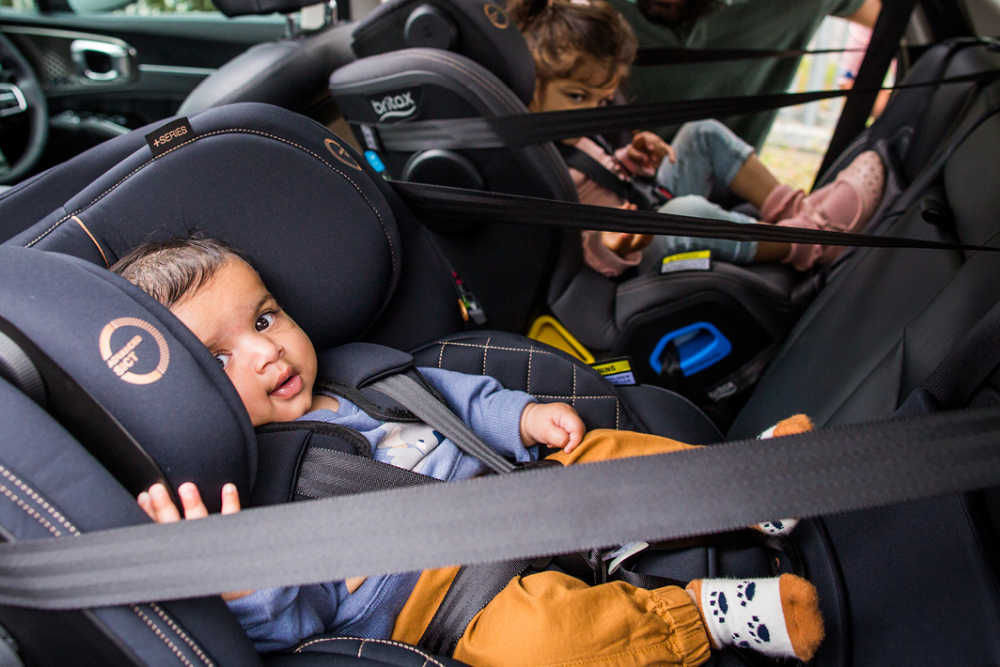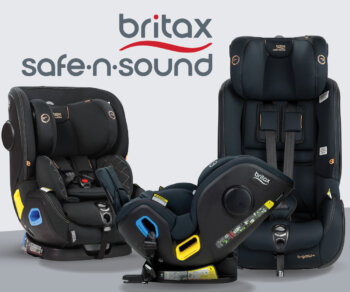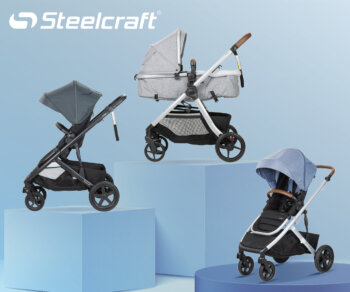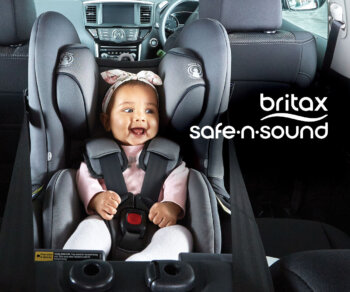Media kindly brought to you by Britax
Car rides with infants and young children can be challenging at the best of times and for a multitude of reasons – restlessness, boredom, and squabbling amongst siblings in the backseat can ruffle the calmest of parents. But it’s nothing in comparison to the prospect of a road collision. A nightmare scenario for any parent, we must consider the possibility very seriously and the role of the car seat in affecting the outcome. In the event of the unthinkable, every parent would like to know they did everything they possibly could to protect their baby or child from the impact of the collision and ensure their survival.
Operating on the philosophy that you can never be *too* safe when it comes to securing children in a vehicle, Kiddipedia reached out to Britax for more of their expert advice on car seats, and specifically, the benefits of rearward-facing car seats and why parents and caregivers should rethink the move to a forward-facing car seat earlier than required or recommended. Britax is a trusted name in the development and innovation of child car seats, with 50+ years’ experience as an industry leader in the Australian market, and is perfectly placed to shed light on the issue.
Let’s take a look at the clear safety benefits of rearward-facing seats, clear up any misconceptions of when it’s appropriate to make the transition, and explore how you can facilitate your child’s comfort in a rear-facing position.
Legal guidelines for rearward-facing car seats
When considering the purchase of your child’s very first car seat or updating their car seat setup as they grow, your approach should always be informed by Australian law and associated mandates. The legislation dictates that babies up to six months must be in rear-facing restraints, and also states that children can be kept in rear-facing car seats until they are four years old.
There is a caveat however, in that children develop at different rates, with Britax reminding us that age is only a guide. They reiterate that a far more accurate indicator of whether your child is ready to transition to their next seat or turn forward-facing, is their height, which can get lost in translation. In fact, 2019 research from the Royal Children’s Hospital Melbourne that polled attitudes and practices of parents, found that only 3% of parents know that children should be at least 145cm tall to safely travel with an adult seatbelt without a booster seat.
Furthermore, the minimum legally enforceable guideline of 6 months doesn’t capture the improved safety profile for children beyond this age, when retaining a rear-facing car seat until the age of 4 or the equivalent height benchmark. In support of their mission to maximise children’s car seat safety, Britax strongly recommends that parents and caregivers look beyond the minimum requirement: “Only move your child out of their seat when they have exceeded the upper height markers on their current restraint and can no longer sit comfortably in it – keeping them rear-facing for longer which is so much safer.”
Problematically, there appears to be a lack of awareness amongst parents and caregivers that is causing a lower duration of rear-facing car seat use. In the abovementioned poll research by Royal Children’s Hospital Melbourne and outlined in their report: Car seat safety: Are Australian children safe?, two thirds (63%) of children are in a forward-facing car seat by 18 months of age.

What makes rear-facing seats safer?
In the 2021 National Guidelines for the Safe Restraint of Children Travelling in Motor Vehicles report developed by Neuroscience Research Australia and Kidsafe, the evidence is clear regarding infants and toddlers’ enhanced safety in rear-facing restraints. This takes into consideration how such restraints conform to their anatomy and addresses their physical vulnerabilities in the event of an impact.
Expert testimony and rigorous testing of rear-facing versus forward-facing restraints has led them to conclude: “Rear facing restraints are highly effective in preventing injuries if used correctly because they fully support the child’s head and neck in the event of a crash. This is important as infants have relatively large heads and weak necks which put them at particularly high risk of serious injuries if the head and neck are not supported.”
Given the overwhelming safety benefits, it’s clear that working to the upper limits of the legal recommendation is the way to go. Of course, not all rear-facing car seats are made to the same quality standards. With leading technology that gives you the ability to keep your child rear-facing for longer, here are 3 options from Britax:
- Britax Safe-n-Sound B-First (birth – four years (approx.): This convertible car seat is the newest incorporation of Britax. B-First features Clicktight Installation System and Advanced Side Impact Cushion Technology (SICT). Clicktight Installation System brings a unique patented technology to Australia, designed to provide effortless and secure installation, every time. Dealing with crash energy earlier, the Advanced SICT combines advanced safety and freedom of space. Designed to reduce everyday misuse, and offer overall increased protection, B-First offers safety and flexibility.
- Britax Safe-n-Sound Millenia (birth – four years (approx.): This restraint is suitable to keep children in a rear-facing position from birth until three years of age (approx.). It includes revolutionary dual layer Side Impact Cushion Technology (SICT™) – Head Protection for safety as well as the Flexi Infant Safety Cushion, which includes EVA composite material that provides support and protection for a small baby absorbing energy during a side impact crash. Thermo5® High Performance fabric with Bamboo Charcoal means your child will travel in quality and comfort.
- Britax Safe-n-Sound Graphene (birth – four years (approx.): This seat features narrow, compact depth which means it’s perfect for small cars that can require multiple seat configurations. Featuring our award winning Thermo5® High Performance fabric with Bamboo Charcoal this seat can be used rear-facing until they are approximately three years old. It also features SICT™ – Torso Protection, making the Graphene our most advanced compact car seat and uniquely designed to offer optimised safety without compromise.
Real-life case study: how a rear-facing car seat saved a life
It’s important that we see more talk in the community about keeping children rear facing beyond the minimum 6 months, however, sometimes the benefit doesn’t hit home until you see it in action. At the point of a vehicle collision, however, there is no turning back on your decision. It’s a reality that is all-too familiar for one Aussie mum as reported in the news, who was involved in a horrific car accident with her 10-month-old-son, and is grateful for the rear-facing car seat that ultimately saved his life.
Zoe ten Broek was facing every parent’s nightmare when her son Jaxon suffered serious injuries from the collision and required four major surgeries to repair a fractured skull, a brain bleed and a torn ligament in his neck. Fortunately, she had kept Jaxon in a rear-facing car seat since birth and beyond the minimum requirement of 6 months, after doing research on car accident statistics and how to optimise child safety when buying a car seat. She says this knowledge was critical in her purchase of a rear-facing restraint, in what turned out to be a lifesaving decision. “If I hadn’t known to keep him rearward facing, he definitely wouldn’t be here, the doctors have told me,” says Zoe. In this way, Zoe’s choice of car seat had kept Jaxon alive from an otherwise certain death, had he been moved to a forward-facing seat.
Recalling the earlier statistic that over half of Australian children are moved out of the safest car setup before the age of 2, there is clearly a lot more awareness required amongst parents and caregivers who may not realise what they’re losing by making the switch too prematurely.
Advice for keeping your child content in a car seat
As we’ve explored above, the evidence is undisputed that keeping your child in a rear-facing car seat for longer is safer. That being said, you may be wondering if it’s a realistic option for older toddlers who may be curious, boisterous or otherwise desperate to see what mum, dad or their grandparents are doing up front. In fact, it’s often the desire to appease children and the expectation that they are most comfortable in a forward-facing position, that leads parents to make a quicker transition away from rear-facing car seats.
As long as their rear-facing car seat is installed correctly and positioned at the right angle, your child will not be uncomfortable – despite how it might look from an adult’s perspective! If you were to change to a forward-facing seat with the aim of soothing a bored child, you’ll find that once the novelty wears off, you’re right back to square one. We know the motto of safety first should reign supreme, but who’s to say your child cannot be both safe and content in a rearward-facing position until they’ve reached those all-important development milestones?
Here are some tips for keeping your child satisfied in a rear-facing car seat as they grow:
- Talk, read or sing to your child from the front seat. Your verbalisation will reassure them that they are not missing out on any of the fun.
- Where possible, time trips to when your child is calmest, so they can make a positive association with the car seat.
- Make use of siblings in the backseat to provide intermittent eye contact and touch
- Provide them a source of entertainment by very securely attaching a multimedia device to the headrest in front of them.
- Consider car-only toys that add novelty and offset boredom during the trip
And there you have it – several sound reasons to retain a rear-facing setup for your child until they reach the age and height requirements to move to a forward-facing car seat. Using these to inform your approach to car seat safety will give you peace of mind that you are doing everything in your power to minimise harm and potential death of your beloved child if the unthinkable was to occur.
Before you go, why not share this information with your family and friends? Together, we can model best practices to help Aussie families secure the futures of their children when on the road. For more great advice and to check out the full Britax car seat range, check out the Britax website.









